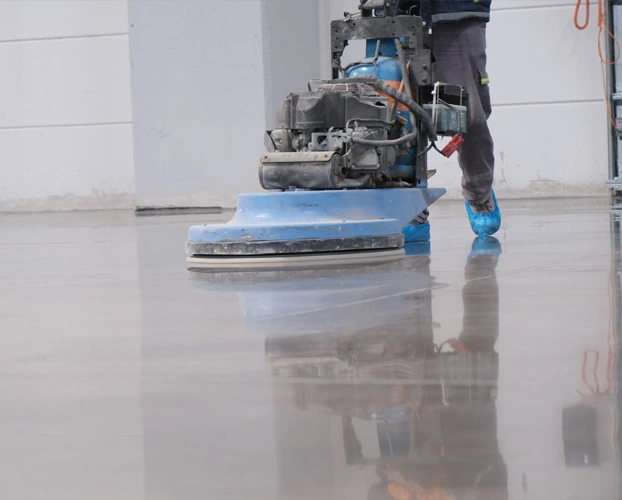Concrete has long been a staple in construction, known for its durability, versatility, and cost-effectiveness. However, beyond its functional applications, concrete is increasingly being recognized for its aesthetic potential.
Polishing the concrete and scheduling concrete polishing in Melbourne from professionals have become popular choices for homeowners, businesses, and builders looking to create stunning surfaces. This guide will take you through everything you need to know about concrete grinding and polishing in Melbourne, from the process itself to its benefits and applications.
Understanding Concrete Grinding
Concrete grinding is the process of using specialized machinery to remove the top layer of concrete. This can be done for several reasons, such as leveling a floor, removing imperfections, or preparing the surface for polishing. The grinding process typically involves the use of diamond tools attached to a heavy-duty grinder, which are designed to wear down the concrete gradually, creating a smooth, even surface.
Why is Concrete Grinding Important?
Concrete grinding is an essential step in many construction and renovation projects. Here’s why:
1. Surface Preparation:
Before concrete can be polished or coated, it needs to be ground down to ensure a clean, even surface. This helps to remove any old coatings, adhesives, or imperfections that could affect the final finish.
2. Leveling Floors:
In Melbourne’s older buildings, uneven floors are common. Grinding can level out these surfaces, making them safer and more aesthetically pleasing.
3. Improving Adhesion:
Before applying coatings or overlays with professional concrete polishing in Melbourne, the surface needs to be roughened up through grinding. This increases the surface area for the coating to bond with, ensuring a longer-lasting finish.
4. Removing Imperfections:
Over time, concrete surfaces can develop cracks, pits, or other imperfections. Grinding can help remove these flaws, restoring the surface to a pristine condition.
The Process of Concrete Grinding
Concrete grinding in Melbourne typically follows a multi-step process.
1. Assessment:
The first step is to assess the condition of the concrete. This involves checking for cracks, unevenness, and addressing other imperfections.
2. Choosing the Right Tools:
Depending on the hardness of the concrete and the desired finish, different types of diamond grinding tools may be used. These range from coarse grit for heavy grinding to finer grit for finishing.
3. Grinding:
The actual grinding process involves running the grinder over the surface of the concrete multiple times, gradually working down through the layers. Each pass uses finer grit, which smooths out the surface more with each iteration.
4. Cleaning:
After grinding, the surface needs to be thoroughly cleaned to remove dust and debris. This ensures that the surface is ready for the next step, whether that’s polishing or applying a coating.
5. Inspection:
Before moving on to polishing, ensure that your professional concrete grinding in Melbourne includes an agreement for inspections.
Understanding Concrete Polishing
Once the grinding process is complete, the concrete is ready for polishing. Concrete polishing is a multi-step process that involves using progressively finer diamond pads to create a high-gloss finish on the concrete surface. The result is a sleek, reflective floor that’s both durable and easy to maintain.
Benefits of Concrete Polishing
Concrete polishing offers several benefits, making it a popular choice for Melbourne properties:
1. Aesthetics:
Polished concrete floors have a sleek, modern look that can enhance the aesthetic of any space. The high-gloss finish reflects light, making spaces feel brighter and more open.
2. Durability:
Polished concrete is incredibly durable and resistant to wear and tear. This makes it ideal for high-traffic areas in both residential and commercial properties.
3. Low Maintenance:
Unlike other flooring options, polished concrete is easy to maintain. It doesn’t require waxing or sealing, and regular cleaning is usually enough to keep it looking its best.
4. Cost-Effective:
Given its durability and low maintenance requirements, polished concrete is a cost-effective flooring option in the long term. It’s also more affordable upfront compared to other high-end flooring materials.
5. Eco-Friendly:
Concrete polishing is an environmentally friendly option, as it utilizes existing materials rather than requiring new resources. Additionally, the reflective surface can reduce the need for artificial lighting, saving energy.
The Process of Concrete Polishing
The concrete polishing process in Melbourne involves several stages:
1. Initial Grinding:
Before beginning the polishing, scheduling concrete grinding in Melbourne is essential to remove any surface imperfections. This ensures that the surface is smooth and even, ready for polishing.
2. Densifying:
A chemical hardener is applied to the concrete, which penetrates the surface and reacts with the calcium hydroxide in the concrete. This process, known as densification, makes the concrete harder and more durable, preparing it for polishing.
3. Polishing:
The polishing process involves using progressively finer diamond pads to grind the surface. Starting with a coarse grit, the surface is gradually polished to a finer grit, creating a smooth, reflective finish. This process may involve several passes, depending on the desired level of gloss.
4. Staining (Optional):
For those looking to add color or design to their polished concrete floors, staining can be applied during the polishing process. This involves using acid-based stains or water-based dyes to create a customized look.
5. Final Buffing:
Once the polishing is complete, the surface is buffed to enhance the gloss and ensure a uniform finish.
6. Sealing (Optional):
While polished concrete doesn’t require sealing, some property owners may choose to apply a sealer for added protection. This can help enhance the longevity of the polished surface and protect it from stains.
Applications of Concrete Grinding and Polishing in Melbourne
Concrete grinding in Melbourne with the process of polishing have a wide range of applications in Melbourne, from residential to commercial spaces:
1. Residential Homes:
Polished concrete is becoming increasingly popular in Melbourne homes for its modern look and durability. It’s often used in living rooms, kitchens, and outdoor areas.
2. Commercial Spaces:
From retail stores to office buildings, polished concrete is a practical and stylish choice for commercial spaces. Its durability makes it ideal for high-traffic areas, while its sleek appearance enhances the overall aesthetic.
3. Warehouses and Industrial Facilities:
Polished concrete is a popular choice for warehouses and industrial facilities due to its durability and low maintenance. The smooth surface also makes it easier to move heavy equipment and reduces wear on tires.
4. Restaurants and Cafes:
In Melbourne’s vibrant hospitality scene, polished concrete is often used in restaurants and cafes for its modern look and ease of cleaning.
5. Educational Institutions:
Schools and universities in Melbourne are increasingly opting for polished concrete floors for their durability and low maintenance, making them a practical choice for high-traffic areas.
Final Words
Concrete grinding and polishing offer a versatile, durable, and aesthetically pleasing solution for a wide range of applications in Melbourne. Whether you’re renovating a home, outfitting a commercial space, or upgrading an industrial facility, concrete polishing in Melbourne provides a cost-effective, low-maintenance option that can enhance the look and feel of any space.
By understanding the processes involved with the help of Premium Concrete Resurfacing, you can ensure that your concrete surfaces have finishing that are of the highest standard, providing a long-lasting, beautiful finish for years to come.

